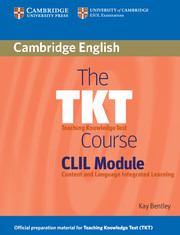Unit 7 - Language demands of subject content and accompanying tasks
Published online by Cambridge University Press: 27 September 2023
Summary
What are the language demands of CLIL subjects?
In CLIL, learners produce, listen to and read a wide range of language. Learning subjects in a non-native language is not the same as learning a foreign language and it is not the same as learning subjects in the first language. CLIL teachers need to analyse the language demands of subject lessons and then plan and prepare relevant language support.
In most subjects, learners meet many different text types, or genres, in CLIL. Many CLIL texts are non-chronological and are used in most curriculum subjects. Every genre has specific features which make it different from other genres. We can help learners to become familiar with the language features associated with different genres. First, we need to identify the type of texts learners meet in their subjects, and then we need to help learners understand the purpose of the text and who it is for. We also need to help them identify language features in those texts. Language features are sometimes described at sentence level and word level.
Key concepts
Can you think of three different genres used in your subject? What are the different genres in CLIL?
We can divide the language features found in different genres into sentence and word levels. Look at the examples in the table.
The genres language learners meet depend on the curricular subjects in CLIL. Specialist vocabulary and topics are different in each subject.
Like texts, reading and writing tasks vary depending on the subject. Look at these examples of some task types learners meet in different subjects:
In science subjects, learners hypothesise, observe experiments, describe procedures and record findings.
In subjects such as history, politics and geography, learners read source materials, recounts, reports and case studies.
In mathematics and economics, learners explain how they solved problems and describe data in graphs and charts.
In subjects such as art and music, learners read and write descriptions and explanations.
In ICT, learners explain word-processed data.
- Type
- Chapter
- Information
- The TKT Course CLIL Module , pp. 37 - 42Publisher: Cambridge University PressPrint publication year: 2010



